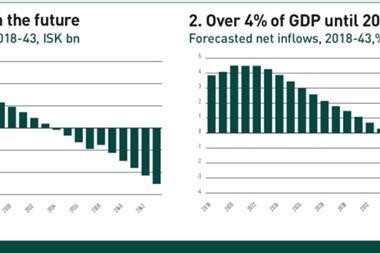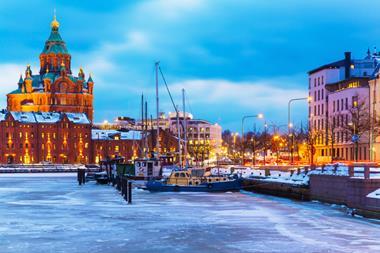The funded Icelandic pension system – already the world’s third largest relative to gross domestic product (GDP) – is set to more than double in size in the next few years, with total assets equating to as much as 320% of the island’s annual economic output, according to the manager of one pension fund.
Diljá Matthíasardóttir, institutional asset management specialist at Arion bank, which has a mandate to run the independent pension fund Frjálsi, said in an article published in local newspaper Morgunblaðið: “The investment environment of the Icelandic pension funds and their portfolios has changed dramatically over the past few decades.”
The funds had grown rapidly and this trend looked set to continue unabated, she said.
The Icelandic pension fund system was now the third largest among OECD countries relative to GDP, Matthíasardóttir said, with the ratio of the funds’ total assets to GDP having grown to 161% at the end of 2018 from 112% 10 years before.
“Favourable demographic developments and the fact that the pension system is relatively young may explain, to a large extent, this rapid growth of the system,” she said.
Matthíasardóttir said: “The outlook for the Icelandic pension system is that it will more than double in size relative to GDP in the coming years.”
Because of this, she said, the country’s pension funds had a great responsibility, and their systematic importance meant they had to move with the times and to continue contributing to the positive development of Icelandic society.
Looking back, she said pension funds in Iceland had seen big asset allocation changes in the first years of this century, with a more diverse mix of asset classes taking over from government bonds, which had been the mainstay of portfolios until then.
Matthíasardóttir’s article shows how the 2008 financial crisis has had a lasting impact on the size and nature of the domestic stock market.
The market value of listed equity is now around ISK1.2tn (€8.6bn) compared to approximately ISK3.6tn in the summer of 2007, she wrote. Over the same time period, the pension system has expanded to ISK5trn from ISK1.6trn.
The domestic bond market, meanwhile, has a market value of some ISK2.5trn, compared to ISK1.4trn in 2007, she said.
While significantly smaller, though, Matthíasardóttir said the stockmarket in Iceland now reflected the economy as a whole much more accurately than it did when the market was dominated by a few large financial institutions.
“Corporate bond issuance has increased, driven by increased demand from the domestic pension funds in light of the low interest rates on less risky assets, such as government bonds,” she said.
Matthíasardóttir also pointed to another relatively new asset allocation direction pension funds had taken, saying they now look more to other factors than regular financial factors when evaluating investments.
“The ideology of responsible investments has emerged and the pension funds have been actively involved in both the development and implementation of the methodology in Iceland and issuance of sustainable bonds has followed,” she said.



























No comments yet